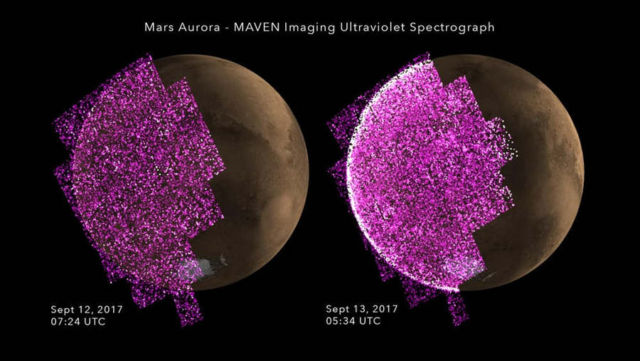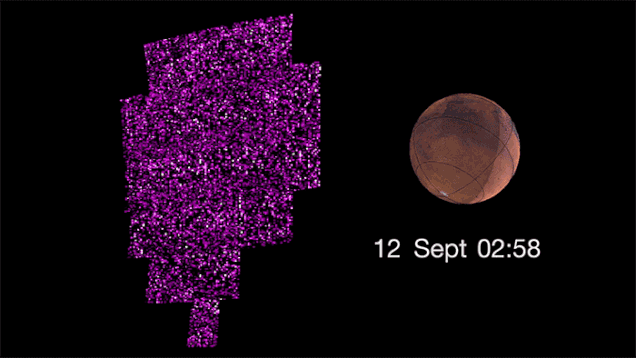An unexpectedly strong blast from the Sun hit Mars this month, observed by NASA missions in orbit and on the surface.
The solar event on Sept. 11, 2017 sparked a global aurora at Mars more than 25 times brighter than any previously seen by the MAVEN orbiter, which has been studying the Martian atmosphere’s interaction with the solar wind since 2014.
Above, images by NASA’s MAVEN spacecraft, showing ultraviolet emissions before (left) and during (right) the storm. Credit: NASA/Goddard/University of Colorado
MAVEN Program Scientist Elsayed Talaat, program scientist at NASA Headquarters, Washington, for NASA’s Mars Atmosphere and Volatile Evolution, or MAVEN, said:
“NASA’s distributed set of science missions is in the right place to detect activity on the Sun and examine the effects of such solar events at Mars as never possible before.”
This animation shows the sudden appearance of a bright aurora on Mars during a solar storm. The purple-white color scheme shows the intensity of ultraviolet light over the course of the event, from observations on Sept. 12 and 13, 2017, by the Imaging Ultraviolet Spectrograph on NASA’s MAVEN orbiter. Credit NASA/GSFC/Univ. of Colorado
It produced radiation levels on the surface more than double any previously measured by the Curiosity rover’s Radiation Assessment Detector, or RAD, since that mission’s landing in 2012. The high readings lasted more than two days.
Strangely, it occurred in conjunction with a spate of solar activity during what is usually a quiet period in the Sun’s 11-year sunspot and storm-activity cycle. This event was big enough to be detected at Earth too, even though Earth was on the opposite side of the Sun from Mars.
Sonal Jain of the University of Colorado Boulder’s Laboratory for Atmospheric and Space Physics, who is a member of MAVEN’s Imaging Ultraviolet Spectrograph instrument team, said:
“The current solar cycle has been an odd one, with less activity than usual during the peak, and now we have this large event as we’re approaching solar minimum.”
source JPL







Leave A Comment